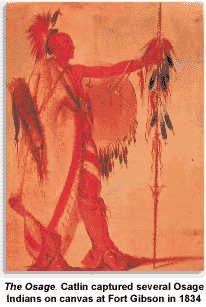George Catlin was an artist, writer, historian, reporter, explorer, trailblazer, anthropologist, and geologist, crusader, businessman, opportunist and also is considered to be a pioneer in American ethnography (the study of specific cultures). He also is credited with the first "national park idea."
Man, in the simplicity and loftiness of his nature, unrestrained and unfettered by disguises of art, is surely the most beautiful model for the painter — and the country from which he hails is unquestionably the best study or school of the arts in the world... and the history and customs of such a people, preserved by pictorial illustrations, are themes worthy the lifetime of one man, and nothing short of the loss of my life shall prevent me from visiting their country, and becoming their historian.- George Catlin
George Catlin was born in Wilkes-Barre, Pennsylvania, in 1796. Indians exerted a strong influence on Catlin's life from an early age. His mother had once been captured by the Iroquois. As a youngster, Catlin enjoyed collecting Indian relics.
Following in his father's footsteps, Catlin was trained as a lawyer, and was also a self-taught artist. He began by painting miniatures, then moved on to full-size portraiture. He painted portraits of political figures and was commissioned for a group portrait of the Virginia Constitutional Convention in Richmond, in 1829.
In 1830, the Indian Removal Act was passed, which forced the Five Civilized Tribes (Seminole, Chickisaw, Choctaw, Creek, and Cherokee) out of the land they had lived on for generations. They were given land in parts of Oklahoma, which was sparsely settled and thought to be of little value. Within 10 years of the Indian Removal Act, more than 70,000 Indians had moved across the Mississippi. Many died on that journey, which came to be known as the Trail of Tears. Catlin witnessed the devastation and destruction of many tribes, and came to view the frontier as a territory of corruption. Like many others, Catlin believed that Native Americans were a vanishing race.
Thus moved, he made the significant decision to leave his law practice and devote himself entirely to his art. He decided that Indians and their culture would be his main subject matter. In 1831, Catlin packed his paintbrushes and began his arduous journey through the remote and wild frontier, to become a historian of American Indians, and document their traditional Native culture.
It was during one of these trips, while in the Dakotas in 1831, that Catlin became concerned about the loss of Indian civilization, wildlife, and wilderness brought about by westward expansion. He considered the idea of preservation when he wrote "by some great protecting policy of the government preserved...in a magnificent park...a nation's park, containing man and beast, in all wildness and freshness of their nature's beauty!"
Catlin traveled to St. Louis and became friends with General William Clark, who 25 years earlier, had joined with Meriwether Lewis to lead an expedition across the continent in search of all-water route to the Pacific Ocean. At the time, Clark was the United States Superintendent of Indian Affairs and Governor of the Missouri Territory. No one could legally travel, trade, or trap along the frontier without the express permission of the superintendent. That position gave Clark contact with nearly every major Indian nation at the time. Catlin painted portraits of Native Americans whose delegations passed through town. Clark brought Catlin on his first trip into the frontier in order to make diplomatic contact with tribes of the Southern Plains. This was the first steamboat voyage up the Missouri.
 From 1830 to 1836, Catlin traveled thousands of miles and visited more than 50 tribes from present-day North Dakota to Oklahoma. He painted landscapes and portraits, studied and documented their habits, customs, and culture. He was the first artist to document the Plains Indians in their own territory.
From 1830 to 1836, Catlin traveled thousands of miles and visited more than 50 tribes from present-day North Dakota to Oklahoma. He painted landscapes and portraits, studied and documented their habits, customs, and culture. He was the first artist to document the Plains Indians in their own territory.
Catlin's art and writings illustrate Indian cultures on the edge of radical change, which would come with U.S. expansion into tribal territories. He openly and strongly criticized the encroachment of white civilization upon Native Americans, which was contrary to evolving government policy at the time. His work culminated in numerous published journals and more than 500 oil paintings. He presented his paintings to Congress in 1838 with a goal of selling his collection as the core of a national museum, but was rejected. Catlin took his work to Europe where they were much more admired. He even had an audience with Queen Victoria.
Although Catlin is most famous for his paintings of the American West and its inhabitants, his travels in the 1830s were not his only adventures. He also traveled extensively in South America and journeyed along the North American west coast as far as the Aleutian Islands and into Siberia.
Today, Catlin's Indian Gallery at the Smithsonian American Art Museum is recognized as a great cultural treasure. His works offer insight into native cultures, which is crucial in American history. His paintings also are part of the permanent collection at the National Gallery of Art and the Virginia Museum of Fine Art. Approximately 450 paintings are extant today.